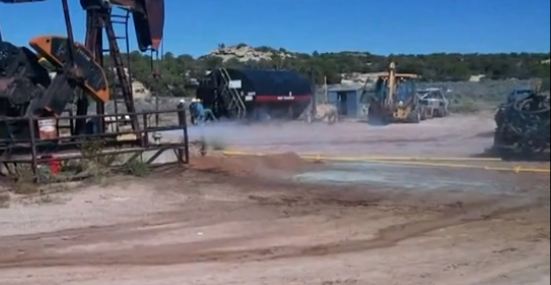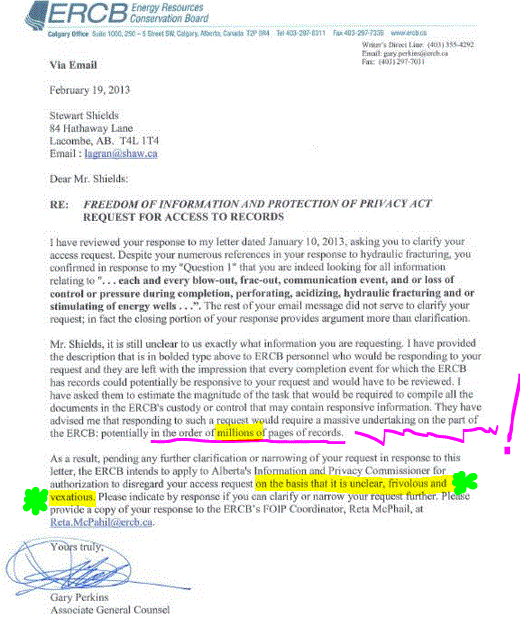Frackers Collide With Traditional Oil Drillers, ‘Frack hits’ are threatening the peaceful coexistence of new and old wells by Erin Ailworth, June 20, 2017, Wall Street Journal
Supersized new oil wells are sometimes running into existing wells, a little-noticed consequence of the shale boom that has started to trigger complaints and lawsuits.
The emerging problem is known as a “frack hit,” and it has flared up in Oklahoma, where a group of small oil and gas producers say more than 100 of their wells have been damaged by hydraulic-fracturing jobs done for companies like Chesapeake Energy Corp. , Devon Energy Corp. and Newfield Exploration Co. …
Some owners of older wells have filed reports with state regulators claiming their wells were flooded with water. In some cases, the wells became so full that the water rose to the surface and spilled over. Others have claimed that they had to shut in wells due to the damage. A few cases have ended up in court.
While newer wells damaging older ones is a longstanding problem, the issue is gaining attention as shale companies employ new technologies to drill wells horizontally.
Almont Energy LLC and TLS Oil & Gas Inc., vertical-well operators in Oklahoma, sued Newfield last year, claiming that fracking jobs performed by Newfield caused an Almont well to flood with water, “negatively impacting the further development potential” of the well.
A lawyer for Almont and TLS declined to discuss the case, which was filed in federal court. Newfield also declined to discuss the case, but spokeswoman Cindy Hassler said the company tries to be proactive when it learns of possible frack hits and works to negotiate compensation with anyone affected if an inspection shows damage.
“Newfield owns thousands of vertical wells ourselves, so we understand the challenges,” Ms. Hassler said.
Chesapeake and Devon, who have also been blamed for frack hits in reports to state regulators, declined to comment.
James West, an analyst with Evercore ISI who has been following frack hits, said they are of special concern in places like Oklahoma and Texas, where those drilling new wells must navigate around older wells drilled over decades.
“It’s becoming a pretty sizable issue,” Mr. West said, noting that Colorado in 2013 enacted regulations after state engineers had identified frack hits as a potential problem. “I suspect every basin is probably facing the same type of challenge.”
In Oklahoma, companies aren’t required to report frack hits unless there is a spill. [No concern for groundwater?] Regulators there have received fewer than 20 confirmed reports of such incidents in the last three years and are currently reviewing several more.
“I know that it’s a larger problem than the data we’ve been given,” said Tim Baker, director of the oil and gas division at the Oklahoma Corporation Commission.
Oklahoma last month passed a bill that eases restrictions on where producers can drill horizontal wells more than a mile long. Vertical-well operators now worry their wells are more vulnerable than before.
Joe Warren, a partner with Brown & Borelli Inc., a small oil-and-gas producer, said roughly two dozen of the company’s wells have been damaged by frack hits. He believes the problem is particularly acute in Oklahoma’s Stack, currently one of the hottest oil regions in the U.S. The Stack has many vertical wells and is now also popular with horizontal drillers.
“Most of the large players in the Stack have hit one or more of our wells,” he said.
Chad Warmington, president of the Oklahoma Oil & Gas Association, questioned claims that hundreds of wells have been damaged. In some cases, he and others argue, frack hits can actually boost production from an affected well. [What when fracs hits your drinking water well?]
But given the potential for damage, the association supports making reporting frack hits mandatory, Mr. Warmington said, and would be open to having a mediation or arbitration process put in place.
Some experts expect the situation will only get worse.
“We’ve got bigger fracks, so more chance of them reaching across, well-to-well,” said Jennifer Miskimins, an associate professor of petroleum engineering at the Colorado School of Mines. “As we get closer and closer spacing, I think we’re going to see the occurrence go up.” [Emphasis added]
[Refer also to:

It can get pretty testy. Encana fracked somebody else’s well – in yet another case of “involuntary stimulation”
2013 08 08: Canada steps up well monitoring to try to avoid ‘frack hits’
2013 08 05: When 2 wells meet, spills can often follow
2013 02 19: FOIP letter from AER (previously ERCB) on all fracks gone bad in Alberta

2013 04 02: Alberta company prevents environmental fracking disasters
A “frac” can go horribly wrong when there is a “communication” breakdown during the process to one or more neighboring wells. A communication breakdown means the fracking well is causing a disturbance with a non-fracking well. The majority of oil companies fracking in Alberta do not currently monitor their frac jobs. If the downhole pressure reaches a point to create “communication” with other wells. The result can be environmentally and financially disastrous, blowing off wellheads, contaminating water sources, spilling frac fluid and oil all over other well site leases.
Like this?



Trying to clean up the ERCB’s reputation (plagued with scandals and the Ernst lawsuit), it’s spots were changed to the AER. Spot removal included legally removing public interest from the regulator’s mandate.

January 13, 2012: Frack hit on farm near Innisfail, Alberta. Photos by Alberta Surface Rights Group
2012 12 18: Fracking blowout report released by ERCB

2012 01 23: ERCB (now AER): Interwellbore Communication During Fracturing Operation Events
2010 03: BC OGC Safety Advisory 2010-03 Communication during fracture stimulation
Fracture propagation via large scale hydraulic fracturing operations has proven difficult to predict.
2006 01 31: Directive 027: Shallow Fracturing Operations-Interim Controls
Information provided by industry to date shows that there may not always be a complete understanding of fracture propagation at shallow depths and that programs are not always subject to rigorous engineering design.
2006 01 27: Directive 027: Shallow Fracturing Operations-Interim Controls
Increased development at ever shallower depths.
Increased Fracture volumes, rates and pressures.
Increased public concern on water well protection.
Lack of regulatory control on fracture design. …
Number of reported incidents of communication at nearby EUB licenced wells
~2004/2005: Shallow “Involuntary Stimulation” events, from EUB (ERCB/AER) library:

